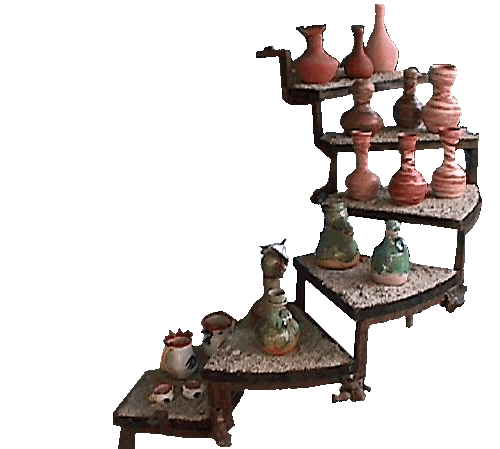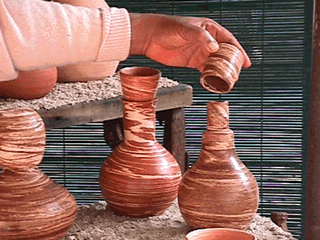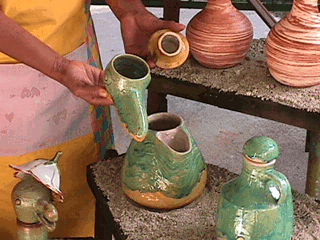At the request of some of our International friends we are uploading the story of the SPES pottery activities. The SPES Pottery started training operations in the year 1978, but it was only officially inaugurated two years later. The head potter was Jacqueline Desvaux de Marigny who had acquired training in South Africa.

All the potters that learn pottery skills at SPES find it inspiring that God was the first potter according to the Bible, Genesis, Chapter 2, Verse 7
“and the Lord God formed man of the dust of the ground and breathed into his nostrils the breath of life and man became a living soul”
Our NGO’s initial intention of using Mauritian Clay has been maintained todate. At the beginning only red local clay was used, it was only later that we discovered and succeeded in using the local grey. It took hundreds of experiments with the technical support of Dr. Krumm from the University of Frankfurt, who came on a geological mission, thanks to aid from UNDP.
Since 1984 products crafted by SPES from the local grey clay have resulted in brighter glaze colours. It was then that SPES had the idea of requesting a South African laboratory to produce a new range of special glazes to match the Mauritian painter Malcolm de Chazal’s favourite gouache colours.
These new vivid coloured glazes can be seen at the head office of the MCB’s entrance hall in a 9 meter by 3 meter imposing Mosaic wall that has a special Chazal Design – now considered a ceramic masterpiece, as SPES individually textured each of the mosaic pieces.
SPES still uses red and grey clays but also started using another of their secret clay mixtures, that is suitable for rapid Raku gas and bagasse firing. It is a black clay, as basalt is dosed with the other two local clays and the resulting glaze effect has a unique blue and copper lustre.
From 1989, SPES has used computers and 3D software to simulate pottery objects. This allows for more creativity and immediate virtual presentation of a “finished-look” of a pottery product. It saves time, as an actual product proto-type does not need to be made for the artist or client can visualize on the computer screen any needed changes to the form or colour to the design. This system of CAD (Computer Aided Design) is especially suitable for marketing on the Internet.
In 1994 SPES introduced salt glazing with aid from UNESCO and WCC (World Craft Council). A Danish expert helped SPES carry out a Regional Pottery Workshop. Two Comorian potters also benefitted from this new type of training, using sea salt. Thus a new range of environmentally friendly products with a Mauritian identity was created and is likely to become popular.
In view of the present drought, to create an awareness and focus on the need to save water, SPES decided to make a retrospective of all the water containers that our Pottery has produced throughout the years, from traditional “gargoulettes” in plain red clay that in the old days were used to keep drinking water cool, to marbled “tubbier gargoulettes” shapes in mixed red and white clay that have top goblets instead of the usual ancient spherical stoppers. (A gargouillette or gargoulette is a porous vase that is used to serve water that becomes fresh through evaporation)

We are proud of the fact that some of our pottery trainees have been awarded top International Prizes at Pottery and Ceramic Competitions. We think the reason why our glazes are considered rather special is because our pottery uses mainly pure rain water, which is collected directly from the roof.
Some of our potters and artists have designed and produced amusing modern shaped jugs in the form of birds. Some are in light green glazes, the colour of the leaves of the sugar cane or are in typical bright Chazal colours. This display was set up for the special “cyber café” mornings SPES organized on the importance of the Water-cycle, and on ways of treating and storing water, saving instead of wasting this precious “blue-gold” commodity.

Virtual photographs were taken at the cyber café for grandparents, educators and children and feature in the combined website update of the months of June and July. SPES is delighted that we have a virtual crafts family and count on continued interaction in this state-of-the-art field.
